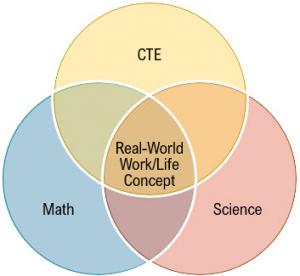Lesson Introduction
Activity: Self-Assessment
Before you begin the course, take a few moments to reflect on the role of science in your CTE classroom. How are you currently teaching science to your CTE students?
Perhaps your students have participated in one or more of the following activities:
- Questioning why a condition or problem related to the CTE program of study exists
- Developing theories that might provide answers to those questions
- Conducting informal experiments like those conducted in a workplace environment
- Collecting, documenting, and analyzing data
- Debating a controversial topic related to an industry or career in the CTE program of study
- Presenting evidence to support a theory using industry-related terminology
If so, then you have been integrating science into your CTE classroom! This course will provide you with further examples and resources to support your students as they engage in science and scientific thinking as part of their CTE program of study.
What is Curriculum Integration?
Examples:
- Students analyze and interpret market research data in a marketing course.
- Students develop and use models in a logistics planning class.
- Students plan and carry out investigations on different types of microphones in an audio visual (AV) technology class.
Features of Effective Curriculum Integration
- Instruction centers around a concept, issue, problem, topic, or experience that students may encounter in a real-world work situation.
- Students explore the content in standards-based academic disciplines connected by a unifying CTE concept that reinforces learning and brings the curriculum to life.
- The concept being explored brings together various aspects of the curriculum in a meaningful way.
Source: Clayton, M., et al. (2011). "Designing Multidisciplinary Integrated Curriculum Units." ConnectED: The California Center for College and Career. Retrieved from https://connectednational.org/wp-content/uploads/2019/03/LL_Designing_Curriculum_Units_2010_v5_web.pdf
Why Integrate Science into Your CTE Curriculum?
Effective math and science integration within the context of the CTE program can
- help students recognize the science involved in a real-world/work situation;
- motivate students to increase their scientific literacy and ability to apply the scientific practices;
- stimulate students’ curiosity;
- strengthen students’ problem-solving abilities; and
- build students’ confidence in communicating with seasoned professionals.
Source: (https://lincs.ed.gov/publications/pdf/IntergratingCurriculum2010.pdf)
The Role of the CTE Teacher
Accomplished teachers design contextualized learning environments that foster critical thinking, creativity, leadership, teamwork, and communication skills while training students for postsecondary education and careers.
Benefits of Integrating Science into CTE Curriculum
Integrating science into CTE curriculum not only provides opportunities for students to make connections between classroom theory and practical application, it also increases their scientific literacy. According to the United States National Center for Education Statistics, scientific literacy is the knowledge and understanding of scientific concepts and processes required for personal decision making, participation in civic and cultural affairs, and economic productivity.
By increasing the scientific literacy of students, they learn to look around, take in facts, and draw conclusions from those facts, as opposed to starting with a conclusion and looking for facts to fit that conclusion. By using the scientific practices within CTE, students will learn to apply this to all aspects of their lives from how they feel about political issues to how they approach a problem once they are in the workforce.




